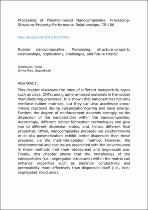 ResearchSpace
ResearchSpace
Rubber nanocomposites: Processing, structure–property relationships, applications, challenges, and future trends
JavaScript is disabled for your browser. Some features of this site may not work without it.
- ResearchSpace
- →
- Research Publications/Outputs
- →
- Book Chapters
- →
- View Item
| dc.contributor.author |
Salehiyan, Reza

|
|
| dc.contributor.author |
Ray, Suprakas S

|
|
| dc.date.accessioned | 2019-02-02T12:44:09Z | |
| dc.date.available | 2019-02-02T12:44:09Z | |
| dc.date.issued | 2018-10 | |
| dc.identifier.citation | Salehiyan, R. and Ray, S.S. 2018. Rubber nanocomposites: Processing, structure–property relationships, applications, challenges, and future trends. Processing of Polymer-based Nanocomposites: Processing-Structure-Property-Performance Relationships, pp. 75-106 | en_US |
| dc.identifier.isbn | 978-3-319-97791-1 | |
| dc.identifier.isbn | 978-3-319-97792-8 | |
| dc.identifier.uri | https://doi.org/10.1007/978-3-319-97792-8 | |
| dc.identifier.uri | https://www.springer.com/us/book/9783319977911 | |
| dc.identifier.uri | http://hdl.handle.net/10204/10660 | |
| dc.description | Copyright: 2018 Springer. Due to copyright restrictions, the attached PDF file only contains the abstract of the full text item. For access to the full text item, please consult the publisher's website. The definitive version of the work is published at https://doi.org/10.1007/978-3-319-97792-8 | en_US |
| dc.description.abstract | This chapter discusses the roles of different nanoparticle types such as clays, CNTs, and graphene-based materials in the rubber manufacturing processes. It is shown that nanoparticles not only reinforce rubber matrices, but they can also accelerate cross-linking reactions during vulcanization/curing and save energy. Further, the degree of reinforcement depends strongly on the dispersion of the nanoparticles within the nanocomposites. Accordingly, different rubber fabrication technologies can give rise to different dispersion states, and, hence, different final properties. Often, nanocomposites prepared via solutionmixing or in situ polymerization exhibit better dispersion than those prepared via the melt-intercalation method. However, the environmental and cost issues associated with the solvents used in these methods limit their widespread and large-scale use. Finally, this chapter shows that the morphology of the nanoparticles (i.e., segregated structures) within the matrix can enhance properties such as electrical conductivity and permeability more effectively than dispersion itself (i.e., non-segregated structures). | en_US |
| dc.language.iso | en | en_US |
| dc.publisher | Springer | en_US |
| dc.relation.ispartofseries | Worklist;21763 | |
| dc.subject | Nanoparticles | en_US |
| dc.subject | Polymer-based nanocomposites | en_US |
| dc.title | Rubber nanocomposites: Processing, structure–property relationships, applications, challenges, and future trends | en_US |
| dc.type | Book Chapter | en_US |
| dc.identifier.apacitation | Salehiyan, R., & Ray, S. S. (2018). Rubber nanocomposites: Processing, structure–property relationships, applications, challenges, and future trends., <i>Worklist;21763</i> Springer. http://hdl.handle.net/10204/10660 | en_ZA |
| dc.identifier.chicagocitation | Salehiyan, Reza, and Suprakas S Ray. "Rubber nanocomposites: Processing, structure–property relationships, applications, challenges, and future trends" In <i>WORKLIST;21763</i>, n.p.: Springer. 2018. http://hdl.handle.net/10204/10660. | en_ZA |
| dc.identifier.vancouvercitation | Salehiyan R, Ray SS. Rubber nanocomposites: Processing, structure–property relationships, applications, challenges, and future trends.. Worklist;21763. [place unknown]: Springer; 2018. [cited yyyy month dd]. http://hdl.handle.net/10204/10660. | en_ZA |
| dc.identifier.ris | TY - Book Chapter AU - Salehiyan, Reza AU - Ray, Suprakas S AB - This chapter discusses the roles of different nanoparticle types such as clays, CNTs, and graphene-based materials in the rubber manufacturing processes. It is shown that nanoparticles not only reinforce rubber matrices, but they can also accelerate cross-linking reactions during vulcanization/curing and save energy. Further, the degree of reinforcement depends strongly on the dispersion of the nanoparticles within the nanocomposites. Accordingly, different rubber fabrication technologies can give rise to different dispersion states, and, hence, different final properties. Often, nanocomposites prepared via solutionmixing or in situ polymerization exhibit better dispersion than those prepared via the melt-intercalation method. However, the environmental and cost issues associated with the solvents used in these methods limit their widespread and large-scale use. Finally, this chapter shows that the morphology of the nanoparticles (i.e., segregated structures) within the matrix can enhance properties such as electrical conductivity and permeability more effectively than dispersion itself (i.e., non-segregated structures). DA - 2018-10 DB - ResearchSpace DP - CSIR KW - Nanoparticles KW - Polymer-based nanocomposites LK - https://researchspace.csir.co.za PY - 2018 SM - 978-3-319-97791-1 SM - 978-3-319-97792-8 T1 - Rubber nanocomposites: Processing, structure–property relationships, applications, challenges, and future trends TI - Rubber nanocomposites: Processing, structure–property relationships, applications, challenges, and future trends UR - http://hdl.handle.net/10204/10660 ER - | en_ZA |





